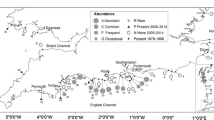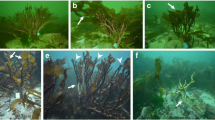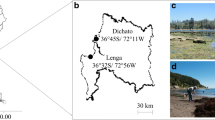Abstract
The distribution of the gametophytes of Asparagopsis armata in Ireland currently encompasses a 75 km radius from a seaweed farm that commercially cultivates this species. This is a smaller range than the historic distribution shows since its arrival in Ireland in 1939. Fragmentation of this alga to seed ropes at a commercial seaweed farm seems to maintain the populations of this introduced species. Without this commercial seaweed farm A. armata would probably not flourish on the Irish west coast and this farm appears to act as a source pool for the populations. The sea surface temperatures (SSTs) of Irish waters are suitable for growth, survival and asexual reproduction of the tetrasporophyte and gametophyte; however, they may not be warm enough for sexual reproduction. The effect of temperature on the life cycle and distribution are discussed. Three species, i.e., Ulva lactuca, Plocamium cartilagineum and Cryptopleura ramosa, were hosts for epiphytic A. armata in summer in over 60% of the collected samples.
Similar content being viewed by others
Abbreviations
- SST:
-
sea surface temperature
References
Andreakis N, Procaccini G, Kooistra WHCF (2004) Asparagopsis taxiformis and Asparagopsis armata (Bonnemaisoniales, Rhodophyta): Genetic and morphological identification of Mediterranean populations. Eur. J. Phycol. 39: 273–283.
Boudouresque CF, Verlaque M (2002) Biological pollution in the Mediterranean Sea: Invasive versus introduced macrophytes. Marine Pollut. Bull. 44: 32–38.
Breeman AM (1988) Relative importance of temperature and other factors in determining geographic boundaries of seaweeds: Experimental and phenological evidence. Helgol. Meersunters. 42: 199–241.
Breeman AM, Meulenhoff EJS, Guiry MD (1988) Life history regulation and phenology of the red alga Bonnemaisonia hamifera. Helgol. Meersunters. 42: 535–551.
Breeman AM, Guiry MD (1989) Tidal influences on the photoperiodic induction of tetrasporogenesis in Bonnemaisonia hamifera (Rhodophyta). Marine Biol. (Berlin) 102: 5–14.
De Valéra M (1942) A red alga new to Ireland: Asparagopsis armata Harv. on the west coast. Irish Nat. J. 8: 30–33.
De Valéra M (1957) A note on the distribution of Asparagopsis armata and Falkenbergia rufolanosa in Ireland as compared with Spain. Coll. Bot. 5: 377–380.
Dixon PS, Irvine LM (1977) Seaweeds of the British Isles. Volume 1. Rhodophyta. Part 1. Introduction, Nemaliales, Gigartinales. The Natural History Museum, London, p. 252.
Drew KM (1950) Occurrence of Asparagopsis armata Harv. on the coast of Cornwall. Nature 166: 873–874.
Feldmann J, Feldmann G (1942) Recherches sur le Bonnemaisoniaces leur alternate de generations. Ann. Sci. Nat. Bot. Biol. Veg. Ser. 2(3): 75–175.
Guiry MD, Dawes CJ (1992) Day length, temperature and nutrient control of tetrasporogenesis in Asparagopsis armata (Rhodophyta). J. Exp. Marine Biol. Ecol. 158: 197–217.
Guiry MD, Hession CC (1996) The seaweed resources of Ireland. In Critchley AT, Ohno M (eds), Seaweed Resources of the World, Japan International Cooperation Agency, Yokosuka, pp. 233–245.
Guiry MD, Cullinane JP, Whelan PM (1979) Notes on Irish marine algae. New records of Rhodophyta from the Wexford coast. Irish Nat. J. 19: 304–307.
Hardy FG, Guiry MD (2003) A Check-List and Atlas of the Seaweeds of Britain and Ireland. British Phycological Society, London.
van den Hoek C, Breeman AM (1990) Seaweed biogeography of the north Atlantic: Where are we now? In Garbary DJ, South GR (eds), Evolutionary Biogeography of the Marine Algae of the North Atlantic. Springer-Verlag, Berlin.
Horridge GA (1951) Occurrence of Asparagopsis armata Harv. on the Sicily Isles. Nature 167: 732–733.
John DM, Prud’homme van Reine WF, Lawson GW, Kostermans TB, Price JH (2004) A taxonomic and geographical catalogue of the seaweeds of the western coast of Africa and adjacent islands. Beih. Nova Hedwigia 127: 1–339.
Kaas R (1996). The seaweed resources of France. In Critchley AT, Ohno M (eds), Seaweed Resources of the World. Japan International Cooperation Agency, Yokosuka, pp. 233–245.
Kraan S, Tramullas AV, Guiry MD (2000) The edible brown seaweed Alaria esculenta (Phaeophyceae, Laminariales): Hybridisation, growth and genetic comparisons of six Irish populations. J. Appl. Phycol. 12: 577–583.
Marshall RA, Harper DB, McRoberts WC, Dring MJ (1999) Vol-atlie bromocarbons produced by Falkenbergia stages of Aspara-gopsis spp. (Rhodophyta). Limnol. Oceanogr. 44: 1348–1352.
Marshall RA, Hamilton JTG, Dring MJ, Harper DB (2003) Do vesicle cells of the red alga Asparagopsis (Falkenbergia stage) play a role in bromocarbon production? Chemosphere 52: 471–475.
Moigne JY (1998). Use of algae extract as antibacterial and/or antifungal agent and composition containing same. World Patent 98/10656 Assignee: Algues et Mer. In: Borowitzka MA (1999) Patents. J. Appl. Phycol. 15: 503–505.
Ní Chualáin F, Maggs CA, Saunders GW, Guiry MD (2004) The invasive genus Asparagopsis (Bonnemaisoniaceae, Rhodophyta): Molecular systematics, morphology and ecophysiology of Falkenbergia isolates. J. Phycol. 40: 1112–1126.
Price JH, John DM, Lawson GM (1986) Seaweeds of the western coast of tropical Africa and adjacent islands: A critical assessment. IV. Rhodophyta (Florideae) 1. Gebera A-F. Bull. Br. Mus. Nat. Hist. Bot. Ser. 15: 1–122.
Ribera MA, Boudouresque CF (1995) Introduced marine plants, with special reference to macroalgae: Mechanisms and impact. Prog. Phycol. Res. 11: 187–268.
Santelices B (1990) Patterns of reproduction, dispersal and recruitment in seaweeds. Oceanogr. Marine Biol. Annu. Rev. 28: 177–276.
Santelices B, Abott IA (1978) New records of marine algae from Chile and their effect on phytogeography. Phycologia 17: 213–222.
Werner A, Clarke D, Kraan S (2004) Strategic review of the feasibility of seaweed aquaculture in Ireland. NDP Marine RTDI Desk Study Series, DK/01/008.2004, p. 120.
Author information
Authors and Affiliations
Corresponding author
Rights and permissions
About this article
Cite this article
Kraan, S., Barrington, K.A. Commercial farming of Asparagopsis armata (Bonnemaisoniceae, Rhodophyta) in Ireland, maintenance of an introduced species?. J Appl Phycol 17, 103–110 (2005). https://doi.org/10.1007/s10811-005-2799-5
Received:
Revised:
Accepted:
Issue Date:
DOI: https://doi.org/10.1007/s10811-005-2799-5




